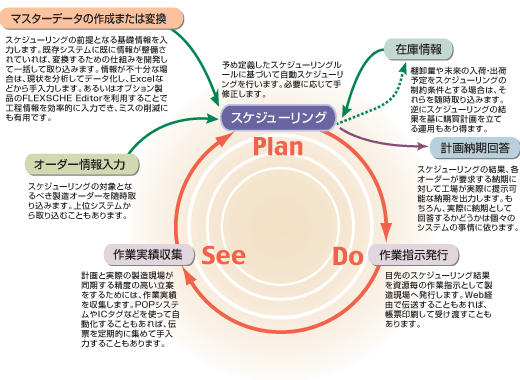Building the FLEXSCHE Scheduling System
Flow of Introducing FLEXSCHE
The procedure from the introduction of FLEXSCHE to the operation of the system naturally varies depending on individual circumstances, but generally follows the flow below.
1. Confirming Functions with the Evaluation Version
Obtain the free evaluation version and confirm whether the functions of FLEXSCHE meet your objectives. The evaluation version of FLEXSCHE allows you to try out all the functions, although the maximum data volume it can handle is limited. Please be sure to compare it with other production schedulers. Thoroughly check whether what needs to be achieved is truly possible with those software. Just because a function name that matches or suggests the required mechanism is listed in the function list, it does not necessarily mean it can be realized, and vice versa. It is important to actually evaluate and verify. If you are not confident whether FLEXSCHE can be applied, please contact your system integrator or FLEXSCHE Corporation (info@flexsche.com). The flexibility of FLEXSCHE meets most requirements.
2. Prototyping
Analyze the target factory or process and create partial data and rules. The evaluation version includes the FLEXSCHE Editor, allowing you to quickly create data and schedule on the spot for verification. If the data volume limitation of the evaluation version becomes an obstacle, consider using the FLEXSCHE rental service (paid). System integrators and FLEXSCHE Corporation will assist as needed.
3. Implementation Work

After selecting the system, the implementation work begins. You must handle many tasks such as data preparation, peripheral development, and scheduling rule setting. The end user, system integrator, and FLEXSCHE Corporation will appropriately share the implementation work. If it is a standalone scheduling system of normal scale, the implementation period is generally about 2 to 4 months, but there are variations depending on individual circumstances. If necessary, FLEXSCHE can be freely extended through programming. FLEXSCHE provides an open development environment, so anyone can develop add-in and other extension modules depending on their skills, but FLEXSCHE Corporation can also undertake development on behalf of the company introducing it or the system integrator upon request.
4. Creation or Conversion of Master Data
The final stage of the implementation work is the preparation of master data. If creating data from scratch, use the FLEXSCHE Editor or Excel, but there may also be cases where a dedicated input support system is developed. If basic data already exists in a higher-level system, the general method is to develop a conversion (import) program from there.
5. Test Operation
Before starting operation, verify whether the created data, scheduling rules, and operation methods are appropriate in parallel with the current operations. If problems are found with planning accuracy or operation form, make corrections.
6. Start of Actual Operation
Place FLEXSCHE at the center of planning operations. For a while after the start of actual operation, pay close attention to the planning operation cycle.
7. Improvement of Operation
While operating FLEXSCHE daily, brush up data settings and scheduling rules. If necessary, functions can also be extended through programming. You can request system integrators or FLEXSCHE Corporation, but depending on your skills, you can also create them yourself.
Support System
-
- FLEXSCHE GP Mailing List
- This is a free mailing list for asking questions about how to use FLEXSCHE GP. FLEXSCHE Corporation staff will respond promptly. Anyone can participate. Please apply from our website.
-
- Annual Maintenance*
- By paying the annual maintenance fee, we will provide the latest version of the product and defect correction versions as needed. It also includes a replacement license key (formerly known as a spare) to prepare for physical failure of the protection key. Additionally, it is essential to continue annual maintenance for future optional product additions and upgrades.
-
- FLEXSCHE GP Training
- You can take paid video training to learn how to use FLEXSCHE GP through videos.
-
- Paid Support
- For various supports by FLEXSCHE Corporation for individual operations and system construction, we will provide a separate estimate. Please contact us.
*There is a free warranty period of 3 months after purchasing FLEXSCHE.
Operation Cycle
The cycle of operating FLEXSCHE generally follows the flow below. Creating and maintaining a smooth flow of information as the core of the production system is also an important role of the production scheduler.

Connection with Other Systems
FLEXSCHE's input and output data are in a completely open CSV format (comma-separated text files) that do not depend on any specific database, making it easy to establish integration with external systems.
Standard equipped with an XML interface that provides smooth connection with existing systems
[Supported Systems]
![Production, Sales, and Logistics Comprehensive Framework [MCFrame] (Toyo Business Engineering Corporation)](img/img_product_installation03_s.gif)
* For details, please contact us.
